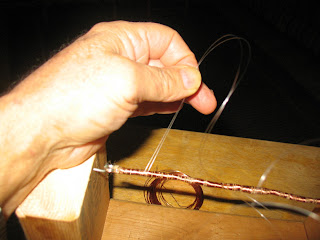I'm going to be adding a post from time to time about
tracking. Let me say up front that I
don't claim any extraordinary skills as a tracker. The FBI does not have me on speed dial to
track down fugitives from justice. I am
a better than average tracker, thanks to the efforts of my teacher; and I will
attempt to share with you the things that he taught me many years ago. I will tell you right now that tracking takes
a lot of patience and a lot of practice.
I, as most folks, don't have the time available that it takes to become
a great tracker; but a little knowledge of techniques and a little practice
will improve anyone's tracking abilities.
Tracking really consists of two main skills. The first is track identification, and the
second is tracking itself. That is, the
ability to follow a series of tracks and other signs in order to determine the
direction of travel and/or location of the critter that made the tracks. This may involve anything from tracking down
a wounded deer, to determining the location for a snare trap, to rescuing a
lost child.
Track identification is the ability to look at a track and
determine what animal made the track.
Track identification is to tracking, as knowing the alphabet is to
writing a story. You can't write a story
without knowing the alphabet, but knowing the alphabet sure doesn't mean that
you can write a story. I'm not going to
include a lot of pictures of tracks in my posts. There are dozens of good books and hundreds
of internet sites that have pictures and drawings of animal tracks and these
are a good place to start learning about track identification; but be warned,
no amount of looking at pictures is going to make you good at track
identification. It is rare thing in the
field to find a complete and clear track.
When I first started learning to identify tracks in the field, my
teacher and I would take a canoe down the Sabine River and stop at each sandbar
to identify the tracks of animals that had come down to the river to
drink. This was an environment where
tracks were often very clear. He would
have me carry a notebook and draw pictures of the various tracks that we found. Then we would make plaster casts of the
tracks to study later.
If you are going to learn to identify tracks I would suggest
that you do the following:
1. Get a good book on track identification, like a Peterson Field Guide to Animal Tracks, and
learn to identify tracks from the pictures.
Don't worry about learning the different gaits at first. It gets a little overwhelming. Just learn to identify the tracks. You can download pictures of tracks off of
the internet and make yourself a set of track flash-cards to help you study.
2. Next, get out into the field. If you have access to a river with sand bars,
that's a good place to study tracks. A
pond or lake with a sandy beach or soft soil on the banks is also pretty
good. If you don't have access to
anything else, you can build a tracking pit.
Building a tracking pit will be the subject of another post. Take a notebook and draw pictures of the
tracks that you find. Don't just draw
the full, clear tracks. Draw the partial
tracks also. Drawing the track will
force you to study them more closely, and little details about the tracks will
emerge. Don't just label the tracks with the name of the animal that made them;
record the season, time of day, location, and type of soil that you find each
track in.
3. Learn to make plaster casts of tracks and start your own
collection of tracks. Record the season,
time of day, location, and type of soil that you find each track in. Making plaster casts of tracks will be the
subject of another post.
My teacher taught me that different families of animals have
similarities between their tracks. For
example: rodents have four toes on their front feet and five toes on their back
feet, members of the weasel family have five toes on both front and back feet. I have organized this information into a
flow-chart that, more or less, traces the mental process that I go through when
identifying a track. In my next post I
will include a copy of this flow-chart to help you identify tracks in the
field.

































.JPG)
.JPG)

.JPG)
.JPG)
.JPG)
.JPG)
.JPG)
.JPG)
.JPG)


